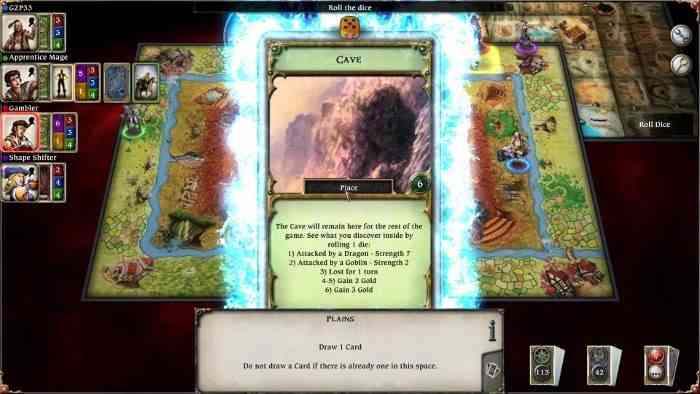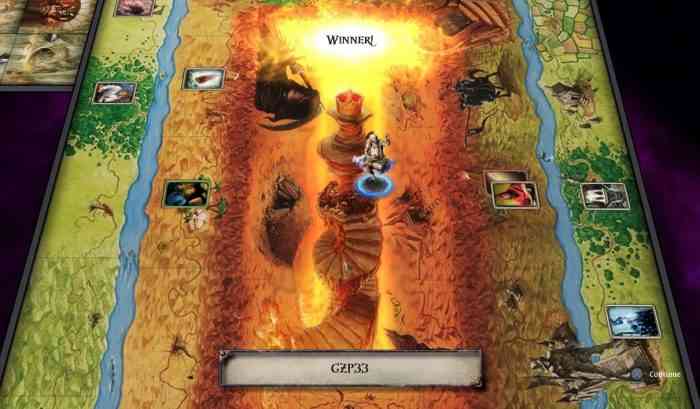Talisman: Digital Edition Review
Talisman has been around for over 30 years, but there’s a good chance you haven’t heard of it. Though beloved amongst a relatively small group of dedicated fans, this “magical quest” style board game never quite reached the heights of other games it takes inspiration from. This is a shame because Talisman is a fun and surprisingly deep board game that takes elements from classics like Dungeons & Dragons and Risk but has enough originality to feel like an entirely separate experience from either of them. But after all these years, Nomad Games wants to put Talisman back on the map with Talisman: Digital Edition. Though it’s unlikely this version will entice many who aren’t already familiar with the game, it’s still an enjoyable adaptation and provides some genuinely addicting gameplay, despite its lackluster presentation.
Since Talisman: Digital Edition is simply a digital version of a physical board game, there is no “story” per se. That being said, the structure of the game and the way it is played make each round feel unique and create the impression of a loose narrative. I’ll spare you the minute details on the rules of the game but the basic goal is to get your character to the center of the board, which is known as the “Crown of Command.” In order to get there, you must roll dice to move spaces and draw “adventure cards” that contain creatures to fight, strangers to encounter, items to equip and so on until you are powerful enough to move onward. The board is comprised of three different levels, and moving between them requires you to perform certain tasks, yet it is possible to reach the center of the board using clever tactics or by sheer luck.
Nearly every action in Talisman, from fighting enemy players to casting certain spells, is carried out by rolling dice, with each potential roll triggering a different outcome; therefore, luck plays a significant factor in whether or not you are successful. One of my biggest complaints with the game is the fact that winning is so reliant on luck. There is some strategy regarding the actions you choose to carry out or how you use cards and spells to their full advantage, but when it comes down to it, if you don’t roll well or you draw bad cards, you are going to lose. Before each match starts, you must choose a character to play as. There are dozens of unique characters to choose from and each one comes with their own individual stats, abilities and look. Though the variety of characters is one of my favorite features in Talisman, it did cause some issues, as a few of the characters felt far more powerful than others.
__________________________
“Talisman takes elements from classics like Dungeons & Dragons and Risk but has enough originality to feel like an entirely separate experience from either of them.”
The controls in Talisman are adequate but take some getting used to. During my first game, I often got confused with the controls and accidentally performed the wrong action on several occasions. There is a lot of information on the screen at any given time, and the developers attempted to utilize the entire controller to allow the player to access all of this information at once. While the idea of this is good, using the L1 button to select one type of card and R1 to select another didn’t make much sense to me in practice. On top of that, there is a cursor icon present on the center of the screen at all times, which begs the question: wouldn’t the controls have been better if the game allowed you to simply move the cursor with the left stick to navigate and access the various items on the screen? This seemed like a logical solution to me, but after a while, I got used to the dedicated control scheme and it became less of a nuisance.

The game modes here are pretty sparse. The single-player and multiplayer modes are essentially the same, with the latter swapping out AI enemies with real people. In my time with the game, however, I was not able to find a single server in the multiplayer mode, leading me to believe the online community for the game isn’t quite off the ground yet. It is worth noting, though, that the PS4 version of the game does include all the expansions to the base game, all of which add additional sections to the board, fun twists or new cards and playable characters.
In terms of graphics, Talisman does a decent job of recreating the original board game in digital form, but the presentation feels lacking overall. There are no eye-catching animations for cards and characters move along as miniature statues just like the real game pieces would. The board itself is also completely flat, but considering the game is centered around moving across different levels, it would have been nice to see some three-dimensionality added, which could have brought the board to life a bit more. If you are familiar with the board game, everything here will make sense, but as a newcomer, I was underwhelmed by what it had to offer from a visual standpoint.

Going in, I wasn’t quite sure what to expect with Talisman, but once I spent some time with it, I was pleasantly surprised with how deep and engaging the board game itself is. At $30, the game is definitely pricey, and though the multiple expansions helps compensate for that, the only people I can really see utilizing them are those who are already fans of the board game to begin with. If you fit into that category or are simply looking for a fun, no-frills digital board game experience, Talisman is one of the better options out there.
***A PS4 review code was provided by the publisher***
The Good
- Deep, addicting board game
- PS4 version contains all expansions
- Dozens of characters to play
The Bad
- Boring presentation
- Too luck-based
- Controls take some getting used to
- Non-existent online community

